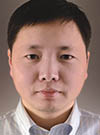“Swing-Dancing” Electrons and Quantum Devices
A research team led by the University of Pittsburgh’s Jeremy Levy has discovered electrons that can “swing dance.” This unique electronic behavior can potentially lead to new families of quantum devices.
Superconductors, which are materials that permit electrical current to flow without energy loss, form the basis for magnetic resonance imaging (MRI) devices as well as emerging technologies such as quantum computers. At the heart of all superconductors is the bunching of electrons into pairs.
 Levy, Distinguished Professor of Physics and Pittsburgh Quantum Institute director, has discovered a long-postulated phase in which electrons form pairs but do not reach a superconducting state. The discovery provides fundamental new insights into a mechanism that could one day be used to design a material that is superconducting at room temperature.
Levy, Distinguished Professor of Physics and Pittsburgh Quantum Institute director, has discovered a long-postulated phase in which electrons form pairs but do not reach a superconducting state. The discovery provides fundamental new insights into a mechanism that could one day be used to design a material that is superconducting at room temperature.
Such a breakthrough would radically transform an array of technologies such as high-speed trains, energy-efficient power transmission, and computers that operate with negligible power requirements. The work, done in collaboration with researchers from the University of Wisconsin-Madison and the U.S. Naval Research Laboratory, was published May 14 in the journal Nature.
One way to understand this novel state is to extend an analogy first articulated by J. Robert Schrieffer, who shared the 1972 Nobel Prize in Physics for the theory of superconductivity. In a superconductor, the motion of paired electrons is highly coordinated, similar to waltzing couples on a dance floor. In the “normal” or non-superconducting state, electrons move independently, bumping into one another occasionally and dissipating energy. What the new research has identified is an in-between state where the electrons form pairs, but each pair moves independently. One may regard the electron pairs as “swing dancing,” where dancing pairs hold hands but do not move in any synchronized fashion.
 The first theory to describe how electrons pair without forming a superconducting state was published by David M. Eagles in 1969. Guanglei Cheng, lead author of the current breakthrough study and a Pitt research assistant professor, described how the Levy lab proved the theory was right: “The breakthrough comes from the technological advancement to fabricate superconducting single-electron transistors at an oxide interface—a technology that allows us to count electrons and pairs one by one. And this is just the beginning. We now have a novel platform to study the fascinating electron-electron correlations at nanoscale dimensions.”
The first theory to describe how electrons pair without forming a superconducting state was published by David M. Eagles in 1969. Guanglei Cheng, lead author of the current breakthrough study and a Pitt research assistant professor, described how the Levy lab proved the theory was right: “The breakthrough comes from the technological advancement to fabricate superconducting single-electron transistors at an oxide interface—a technology that allows us to count electrons and pairs one by one. And this is just the beginning. We now have a novel platform to study the fascinating electron-electron correlations at nanoscale dimensions.”
Levy and Cheng also worked with a research team led by Chang-Beom Eom at the University of Wisconsin-Madison and employed theoretical contributions from C. Stephen Hellberg at the U.S. Naval Research Laboratory. The research was supported by grants from the Air Force Office of Scientific Research and the National Science Foundation.
Other Stories From This Issue
On the Freedom Road

Follow a group of Pitt students on the Returning to the Roots of Civil Rights bus tour, a nine-day, 2,300-mile journey crisscrossing five states.
Day 1: The Awakening
Day 2: Deep Impressions
Day 3: Music, Montgomery, and More
Day 4: Looking Back, Looking Forward
Day 5: Learning to Remember
Day 6: The Mountaintop
Day 7: Slavery and Beyond
Day 8: Lessons to Bring Home
Day 9: Final Lessons

